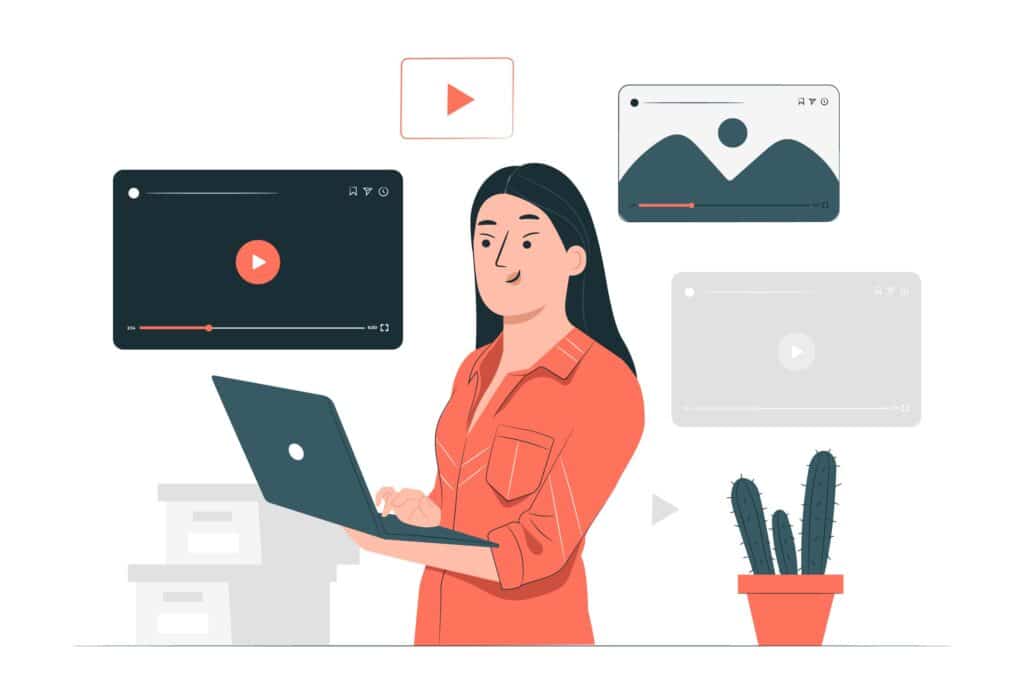Longer buying processes and smaller, more specific audiences are common challenges for B2B marketers.
By dealing directly with other companies, your business needs to demonstrate immense expertise in the solutions it offers, which can be achieved with a good content marketing strategy.
As you know, the digital marketing scenario changes with extreme agility. Therefore, the brands that achieve the greatest success are those that track trends and know how to approach the customer in the most appropriate way, which includes the choice of proper channels and the production of content considered relevant.
To help you stay on top of the subject, we’ve prepared this list with 14 B2B content marketing strategies.
Understanding the data and knowing how to act on it can elevate your marketing efforts to another level. After all, data intelligence is fundamental for efficient decision-making. Want to know more? Keep reading!
Download this post by entering your email below
What is B2B Content Marketing?
Most people have heard of B2C content marketing, but what is B2B content marketing? B2B (business-to-business) content marketing is the process of creating and distributing useful, relevant, and consistent content to attract and retain a defined audience – and ultimately, to drive profitable customer action.
Content marketing involves understanding who your target audience is and what their needs are to create content that provides value.
Content can include blog posts, e-books, infographics, webinars, white papers, case studies, videos, and more.
The goal of B2B content marketing is to attract and retain customers by providing them with valuable information that helps them make an informed decision about a product or service.
Content should focus on helping the customer understand how a particular product can help them solve their problem and why they should buy it from you.
The Difference Between B2B and B2C Content Marketing
B2C or business-to-consumer, content marketing is geared towards creating content that appeals to an individual consumer.
It’s typically focused on generating brand awareness and building relationships with customers in order to drive sales.
B2B content marketing, on the other hand, seeks to address the needs of a business customer. This includes providing them with valuable information such as:
- Product specs and features
- Industry news and trends
- How-to guides and videos
- Case studies showing impactful results from using a product or service
B2B content marketing is focused on helping the customer make an informed decision about a product or service. It also helps to build credibility for your business, as you are providing important information that can help them make a smart purchase.
Ultimately, the goal of B2B content marketing is to build relationships with potential customers and turn them into loyal customers who will keep coming back to your business again and again.
By providing useful and relevant information, you can gain their trust, demonstrate your expertise in the industry, and establish yourself as their number-one choice for the product or service they need.
Why do I need to worry about content marketing?
For most business owners, the last thing they worry about is creating content for their website, blog, or social media profiles.
However, content marketing is an important part of any successful digital marketing plan and can help to attract new customers, build relationships with current customers, and increase the visibility of your business in search engine results.
Content marketing also helps to position you as an authority in your industry by providing valuable information to your target audience.
When you create content that answers their questions, solves their problems, and provides real value, it can help to build trust with customers and make them more likely to purchase from you in the future.
For instance, let’s say you’re trying to convince a business to invest in your cleaning services. How will you do this? You could create content such as a blog post highlighting the benefits of professional cleaning and how it can help their business.
This type of content could be used in email campaigns, on social media, or even shared with existing customers to build trust and show your expertise.
Content marketing is an important part of any digital marketing plan and can help you reach new customers, build relationships with existing customers, and establish yourself as an industry leader.
With a well-thought-out content marketing strategy and the right tactics in place, you can effectively promote your business and increase sales.
Unfortunately, without the right strategy and execution, content marketing can be challenging. That’s why it’s important to have a clear plan in place before jumping into content creation.
When it comes to B2B content marketing, it’s essential to understand your audience and create content that addresses their needs and helps them make an informed decision about your product or service.
Understanding Your Content and Audience
Put yourself in the shoes of your customer. You’re a business owner worried about overhead costs, and you need to find an affordable and reliable service or product. You’re looking for information that can help you make a smart decision about who to choose for the job.
What type of content would be most useful to you? Product specs and features, industry news and trends, case studies showing real-world results from using a product or service, or how-to guides and videos?
As a content producer, it’s vital to understand what type of content your audience is looking for and create content that speaks directly to their needs. Your content should be engaging, informative, and helpful in order to build credibility and trust.
By identifying your target audience, understanding the types of content they are looking for and creating valuable content tailored to them, you can ensure that your B2B campaign will be effective.
How to calculate content marketing metrics?
Of course, the only way to know if your content marketing efforts are paying off is to measure the results. Tracking key metrics is key in ensuring your content marketing campaign is generating leads. Suck metrics include:
- Click-throughs: The number of people who clicked on a link to your website, blog post, or product page.
- Engagement: The number of interactions your content receives, such as likes, shares, comments, and views.
- Leads: The number of leads generated from your content marketing efforts.
- Conversions: The number of leads that have converted into customers.
By tracking these metrics, you can gain insight into how your content is performing and make adjustments to your content strategy as needed. Some tools that can help include Google Analytics, Kissmetrics, and HubSpot.
Ultimately, content marketing is an effective tool to use in your digital marketing strategy.
By understanding your audience and knowing how to measure the success of your content, you can ensure that your B2B campaigns are generating leads and increasing sales.
Don’t believe us? Read on below for some interesting and exciting statistics about the use of content marketing in B2B!
22 B2B Content Marketing Statistics
1. Most B2B marketers say lead generation is their most important content marketing goal.
A complete content marketing strategy can achieve several objectives, such as increasing brand equity and educating potential consumers. In a B2B business, however, the main goal is to find more and more business opportunities.
Unlike B2C businesses, which focus on building relationships with individuals, B2C has lead generation as its main priority. This fact is indicated in a study conducted by Ring Lead, in which 85% of respondents stated that generating new business opportunities is their primary goal in strategy.
2. Most professionals believe that having a good content strategy is a major key to their success.
To achieve the main objective and generate new prospects for the company, it is essential to have a well-structured content strategy.
In the B2B Content Marketing study, conducted in 2017, 72% of the professionals interviewed stated that the production of quality materials was the main factor in their success over the last few years.
This fact is reinforced by a study by the Content Marketing Institute, which points out that an excellent content strategy if paired with good SEO practices, generates three times more leads than an investment in sponsored links.
3. The “most successful” content marketers have a documented strategy in place.
There is no point in establishing a strategy if you don’t map out your results and don’t count on efficient planning. After all, you need to rely on pre-defined performance metrics and collect data that indicates the efficiency of the approach.
By cross-referencing this information, you can identify points for optimization.
You can determine your most relevant metrics according to the characteristics of your company and your objectives in the market. But if you’re wondering about the most used indicators to evaluate a content strategy, the answer is Total Sales, according to HubSpot research.
This idea is reinforced by B2B Content Marketing 2020, which indicated that 69% of the companies considered most successful in the B2B scenario had a documented strategy.
Also, among the worst performers, only 16% have such an approach.
4. The majority of B2B marketers credit e-mail as the most effective distribution channel for demand gen efforts.
Emails remain one of the main channels for you to communicate with your public, especially for nutrition and conversion purposes.
Using newsletters to keep leads informed about their content is just one way to use email marketing to your advantage.
According to a study by the Content Marketing Institute, 79% of B2B professionals believe that email is the most efficient channel for generating demand for the solutions offered. Also, the financial returns are visible.
According to Smart Insights, this type of strategy presents an ROI of $40.00 for every dollar spent.

5. Most B2B companies use strategic landing pages to acquire leads.
But how do you establish an email marketing approach without counting potential customer contact lists? Impossible, don’t you agree?
As buying leads is not a practical option, you need to find other ways to capture the information and contact those interested in your services. That’s where the landing pages come in.
These pages, which offer some valuable content in exchange for visitors providing data, are used by 68% of B2B businesses to acquire leads, as indicated by Marketo. If you want to increase the efficiency of this feature further, consider turning your landing pages into interactive ones.
6. Most of the successful B2B companies craft their content based on specific stages of the buyer’s journey
You’ve heard of the customer lifecycle journey, right? It’s the journey the consumer takes from the moment he discovers he has a problem to the moment he acquires his solution, which can extend to customer loyalty.
Your brand needs to create the motivation to lead them through the stages of the journey.
To do this, nothing better than producing content specifically based on each stage. In the discovery phase, for example, educational materials, such as blog posts and infographics, may be an appropriate option.
In the conversion phase, using interactive calculators to highlight the available benefits may be what you need to close the sale.
By observing the results of B2B Marketing Content, this idea becomes even more evident. Among the most successful companies, 74% use this type of approach.
Among the worst performers, only 26% adopt specific content for each stage of the journey.
7. More than half of B2B marketers prioritize creating visual assets as part of their content marketing strategy.
In addition to producing differentiated content for each stage of the funnel, it is essential to diversify the formats used. Texts, videos, images, and audio are just some examples of materials that can contribute to the conversion of your leads.
Among these, one of the most prominent is the visual content.
According to HubSpot, 51% of B2B marketers focus on visual elements to optimize the consumer experience. Here, there is no more explicit example than the use of infographics, preferably interactive.
According to Forbes, 84% of companies that use this resource consider it very useful.
8. Top-performing B2B blog posts include “the future of.”
Speaking about different content formats, blog posts remain the flagship of several digital marketing strategies. According to the OptionMonster study, more than 409 million people access more than 40 billion blog pages per month, generating about 77 million monthly comments.
To generate such engagement, however, it is essential to excel in attracting the audience’s attention, which starts with the choice of subject and title of the post.
As the B2B audience is hugely connected to market trends, it is no surprise to note, in this Buzzsumo study, that the best-performing posts have the words “the future of” in their title. Other relevant headlines include:
- “How to use”
- “Need to”
- “How to create”
- “Here is how”
- “You need to know”
9. Most companies outsource their content marketing
Increasingly relevant in companies of all segments, content marketing is an activity that can take much time from the company’s professionals.
For you to have an idea, OptionMonster points out that the average production time of a blog post is three and a half hours.
Of course, many companies outsource this type of service to have professional support and avoid overloading their employees.
Approximately 62% of businesses that already work with a content marketing strategy have a partner for the production and dissemination of the materials.
10. Almost all marketers believe that content interactive influences buyer’s decisions.
Articles containing elements of interactivity are rising in popularity among marketers. Calculators, infographics, quizzes, and e-books are just some examples of interactive content that can positively impact the consumer journey.
In this study, conducted by Ion in partnership with Demand Metric, 96% of marketing professionals believe that an interactive marketing strategy has the power to influence the buyer’s decision-making process.
11. Most marketers believe interactive content is effective at educating buyers
If we stop to analyze each step of the journey individually, we will notice that interactive content can be extremely efficient for several purposes. At the discovery stage, for example, your company needs to have proper levels of organic reach, which can be achieved by content sharing.
In Ion’s study with Demand Metrics, 63% of the professionals interviewed stated that interactivity is at least somewhat effective in stimulating users to share the material. When asked about static content, only 32% shared the same sentiment.
Once you succeed in reaching and attracting a lead, you need to nurture them with informational content, enabling their education on the subject.
At this stage, interactivity is also a great ally. 90% of the respondents said they believe in the effectiveness of interactive content to achieve this kind of goal.
12. 88% of marketers will increase the production of interactive content this year.
If you still have doubts about the current relevance of interactive content production, it’s time to put them aside.
According to Go Gulf, this kind of strategy has attracted so much attention from marketers that 88% of them promise to insert interactivity in 10-30% of their content produced in the year 2020.
This can be explained mainly by the impact the strategy can have on the company’s finances. According to the Demand Metric survey with Ion, 68% of the participants interviewed stated that they have been observing revenue growth in their companies.
It is essential, however, to know what types of content are the most effective.
According to the same survey, 22.6% of marketers who work with interactive marketing consider that assessments are the formats that present the best results, followed closely by interactive white papers, mentioned by 22% of participants.
Quizzes and contests come right after, with 19% each.
13. Most marketers believe content is most effective in the early stage of the journey.
We can separate the consumer’s journey into three stages: early, middle, and late. The first is when the lead becomes aware of his problem and begins to seek information and solutions that solve help them.
The second represents the stage when consumers start to compare different alternatives to buy from, while the late stage is where the purchase happens.
According to marketers interviewed by Ion, the use of content is more effective in dealing with leads in the early stage of the funnel. 46% think that way.
Another 40% point to the middle stage as the most important phase for content use, while 14% consider it to be the late stage.
14. More and more marketers are adopting videos in their content strategy.
Another content format that has been gaining more and more followers is video, which may or may not be interactive. Audiovisual content is more natural to consume, especially for people who have more busy routines.
It is also a way to adapt to the preferences of the younger generation and enable their engagement.
A study by Animoto, for example, revealed that 75% of millennials consume videos on social networks every day.
In addition, this content format is perceived as reliable by 40% of users who fit this age group. Millennials, however, are not the only ones who consume videos on the Internet.
It is not surprising to note in a study conducted by Invisia, that the consumption of video content shows an annual growth of approximately 100%.
Attentive to the market, 89% of marketers already make use of video in their content strategies.
By analyzing these B2B content marketing statistics, you will notice trends your company can explore to optimize the customer’s lifecycle journey. As you’ve seen, using different channels and always cherishing the lead’s experience are some points that cannot be ignored.
Also, the quality and relevance of your content are critical to attracting, converting, and retaining customers.

15. The most successful companies spend up to 70 percent of their marketing budget on content marketing
Content marketing is becoming an essential tool in the marketing plans of successful companies. In fact, to some, it is the most essential marketing component. This is true of industries ranging from B2B manufacturing companies to consumer retailers.
Consider these content marketing metrics: according to a recent SEMrush survey of content marketers in 40 countries, “73% of companies that spend from 10% to 70% of their total marketing budget on content marketing were very successful.”
The survey also found that companies collectively increased their spending on content marketing from 2020 to 2021.
16. Quality trumps quantity when it comes to digital content
Content continues to be “king,” but B2B consumers are increasingly fed up with content that doesn’t offer value. This is confirmed by this SEMrush survey, where more than half of successful content marketers listed producing quality content as their number one goal for the future.
High-quality content not only attracts and keeps consumer interest, but it helps your content rank well on search engine results. Given that more than 90% of consumers choose an article from the first page of search results, high-quality content is essential to meet your content marketing goals.
What is high-quality content? At a minimum, it should be unique and not a rehash of other material that can be easily found on the internet. It should also be actionable. For example, if your company sells tax software for small businesses, you might write about business deductions you might have missed, or if your company sells lawn equipment, you might write about how to change the oil filter in your mower.
17. Infographics are the most shared type of content
If you want your content to go viral, consider adding a few infographics to your mix of text, images, videos, and other content. According to a study by OKDork, infographics are among the most shared content on the web.
List articles were the second most commonly shared type of content. This study also found that long-form content was shared more frequently than short articles and blog posts.
What day of the week is best for posting content that will get shared? Tuesday, according to the OKDork study. This is followed closely by Thursday and Monday. The number of shares on Saturday or Sunday is less than half of the Tuesday number.
Infographics appeal to readers who absorb information better visually than via text. For example, these mini-posters might be flow charts or visualization of statistics about your industry or product. Ideally, a good infographic is visually pleasing, tells a story and is designed so that the eye is led to look at all elements of the post in the right order.
18. Podcasts are more than a fad
If you’ve been hesitant to add a podcast to your mix of content because you thought these broadcasts were something of a fad, it’s time to think again. According to a study by Statista, “45% of global internet users aged 25-34 listen to podcasts”. The study also found that 40% of Americans listened to podcasts and that 15% of them listened to a podcast weekly.
Nearly half of the listeners enjoy their podcasts at home, with another 22% listening in their cars.
19. The use of interactive content is growing
The vast majority of content marketing professionals (93%) see interactive content as effective, according to a study by Go Gulf. In addition, 88% of marketers will make 10-30% of their content interactive this year.
What is interactive content? It’s content where users do more than just read an article or look at an image. This includes quizzes, contests, tools, assessments, and calculators.
The study found that interactive content is most effective in the early stages (the discovery and awareness stages) of the sales cycle.
20. Content marketing is worthy of at least one full-time dedicated employee
Gone are the days when the department manager or small business owner posted on Facebook and wrote articles for the company website.
Today, 59% of companies reported having between one and five employees whose jobs are dedicated solely to content marketing, according to the “B2B Content Marketing 2022 Report.”
Only 32% of B2B marketers said they didn’t have even one dedicated content marketing employee.
Job descriptions for these employees include posting on social media, websites, blogs, and other content platforms; responding to comments, reviews, and questions on posts; creating and maintaining the content calendar; and sourcing topics and media to use for posting.
21. Virtual events and webinars score big with B2B content marketers
Virtual events have become increasingly popular, encouraged by the work-at-home environment boosted by the pandemic.
According to the B2B Content Marketing 2022 Report, “more than half (58%) of B2B content marketers said virtual events/webinars/online courses produced the best results for their content marketing in the last 12 months.”
Virtual events run the gamut, from Facebook live events to virtual seminars. According to a study by Vfairs, “92% of companies are continuing to host virtual events even after physical events have resumed.”
Nearly half of the companies surveyed (48%) planned to host more virtual events in 2022 than they did in 2021.
22. The mechanics of good SEO are becoming more refined
SEO is becoming an ever more exact science. For example, a 2022 report by SEMrush found that titles with seven or fewer words “average 36% more organic traffic than those with 14 or more words”.
In addition, the same report found that “posts with more than seven images get 116% more organic traffic than articles containing just text”.
Don’t think that SEO is a bygone science. According to a report by Terakeet, “good SEO can reduce the cost of customer acquisition by an average of 87.41%, compared to digital advertising.”
Final Thoughts
Knowing about the statistics is critical, as you could see, but before that, you must ensure that high-quality content is at the core of your strategy.
That’s why Rock Content offers you a 14-day WriterAccess free trial. There, you can find the best experts to produce content that will perform.
Besides, it includes AI tools to help you generate ideas, create your editorial calendar, identify AI-written content, and more.
What are you waiting for?



![[ROCK NA] [EBOOK SEO] Complete Guide](https://rockcontent.com/wp-content/uploads/2024/06/banner_Search-Engine-Optimization.png)






